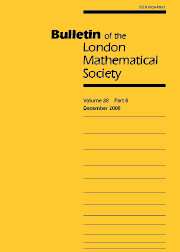Article contents
EGGS IN ${\rm PG}(4n - 1, q), q$ EVEN, CONTAINING A PSEUDO-CONIC
Published online by Cambridge University Press: 24 August 2004
Abstract
An ovoid of ${\rm PG}(3,q)$ can be defined as a set of $q^2+1$ points with the property that every three points span a plane, and at every point there is a unique tangent plane. In 2000, M. R. Brown proved that if an ovoid of ${\rm PG}(3,q)$, $q$ even, contains a conic, then the ovoid is an elliptic quadric. Generalising the definition of an ovoid to a set of $(n-1)$-spaces of ${\rm PG}(4n-1,q)$, J. A. Thas introduced the notion of pseudo-ovoids or eggs: a set of $q^{2n}+1$ $(n-1)$-spaces in ${\rm PG}(4n-1,q)$, with the property that any three egg elements span a $(3n-1)$-space and at every egg element there is a unique tangent $(3n-1)$-space. In this paper, a proof is given that an egg in ${\rm PG}(4n-1,q)$, $q$ even, contains a pseudo-conic (that is, a pseudo-oval arising from a conic of ${\rm PG}(2,q^n)$) if and only if the egg is classical (that is, arising from an elliptic quadric in ${\rm PG}(3,q^n)$).
Keywords
Information
- Type
- Papers
- Information
- Copyright
- © The London Mathematical Society 2004
- 5
- Cited by

